Most insects try to escape from predators by flying away. But it is even better not to be seen at all. Insects that hunt other creatures also need to be invisible to creep up unnoticed on their prey. Many insects have special colors and patterns on their bodies to help them look like leaves, seeds, twigs, or stones. These natural disguises are called camouflage.
Stick insects change their body color to match their surroundings, and so remain hidden almost anywhere. Their long slender bodies and sticklike legs make them hard to see among twigs and leaves. Stick insects are easy to take care of at home. You can buy them at some pet shops. Try the test opposite to find out more about camouflage.
You could look outside for ways in which insects disguise themselves. The last project shows you how to attract insects, such as butterflies and wasps, by planting flowers and herbs. Remember to ask permission from an adult before you start.
YOU WILL NEED
- Camouflage test:
Scissors, light and dark green paper, two cardboard boxes, tape, stick insects, paintbrush, privet or ivy leaves, kitchen paper, muslin, nonhardening modeling material, notebook, colored pencils.
- Rearing stick insects:
Earth, small tank or large jar, privet or ivy leaves, glass of water, sticks, stick insects, kitchen paper.
- Plant a window box:
Garden gloves, window box or large tub, earth, soil mix (optional), package of wildflower seeds, watering can, notebook, pencil, field guide.
CAMOUFLAGE TEST
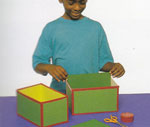 STEP 1
STEP 1
Cut pieces of colored paper to line the insides of the cardboard boxes. Make one box light green, and the other dark green. Attach the paper with tape.
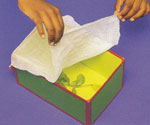 STEP 2
STEP 2
Transfer your stick insects with a paintbrush to the light green box. Add leaves and damp kitchen paper. Cover with muslin weighted at the corners with modeling material.
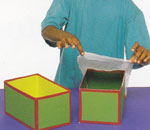 STEP 3
STEP 3
Leave the box in a light place for a day. Record the insects’ color with colored pencils. Put the insects in the darker box. After a day, check to see if they have changed color.
REARING STICK INSECTS
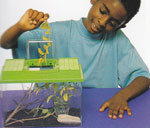 STEP 1
STEP 1
Put a layer of earth in the bottom of a tank or a large jar, with a tight-fitting lid with small air holes. Add privet or ivy leaves in a glass of water, some sticks, and your stick insects.
 STEP 2
STEP 2
Put some wet kitchen paper in a corner, so that the insects have enough moisture. Remember to replace the paper regularly. Ask the pet shop if your insects need anything else.
PLANT A WINDOW BOX
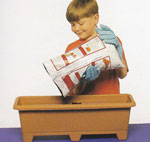 STEP 1
STEP 1
Wearing gloves fill a window box or a large tub with earth. You could add some soil mix to the earth, and mix it in. the container should be about three-quarters full of earth.
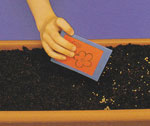 STEP 2
STEP 2
Scatter wildflower seeds over the soil. You can buy seeds, such as daisy and bird’s-foot trefoil, at a nursery. Do not dig up wild plants. Cover the seeds with more earth.
 STEP 3
STEP 3
The seedlings will come up in a few weeks. Water the young plants regularly. As the plants grow, record in your notebook which insects visit and feed on them.
Back to School Projects Main









